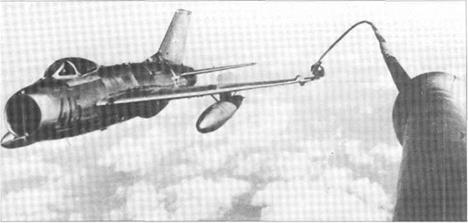MiG-19 Experimental Versions

Design Bureau: OKB-155 of A I Mikoyan
Throughout the massive production of the MiG-15 and MiG-17, with a combined total exceeding 22,000, the MiG OKB was eager to discard the British-derived centrifug al engine and build truly supersonic fighters with indigenous axial engines. It achieved this in sensible stages. The M, or I-350, introduced the large TR-3A axial engine and a wing with a leading – edge sweep of 60°. The SM-2, or I-360, powered by twin AM-5 axial engines, at first was fitted with a high T-type tail. Then the tailplane was brought down to the fuselage, the design was refined, and as the SM-9 with afterburning engines (first flown 5th January 1954) achieved production as the MiG-19. The SM-9/3 introduced the one-piece ‘slab’ tailplane, with no separate elevator, and this was a feature of the MiG-19S. Powered by two RD-9B engines each with an afterburning rating of 3,250kg (7,1651b), this had the devastating armament of three NR-30 guns, each far more powerful than the British Aden of the same calibre. The following specification is for a typical MiG-19S.
|
Dimensions
|
SM-10
Though it had a generally longer range than its predecessors the MiG-19 was required in a decree of May 1954 to be developed with flight-refuelling capability. At that time the only tanker was a version of the piston-engined Tu-4, and a series MiG-19, callsign 415, was fitted with a probe above the left (port) wingtip, feeding into a large pipe with diverters and non-return valves to fill all the aircraft tanks. By 1956 testing had moved to an extraordinary test-bed, callsign 10, fitted with no fewer than four probes. One was at the bottom of the nose, another at top left on the nose, a third on the leading edge of the port
wing and the fourth projected with a kink from above the starboard wing.
SM-20
This was a MiG-19S modified as a pilotless aircraft to test the guidance system of the Kh – 20 cruise missile. This huge weapon was designed to be carried under a special version of the Tu-95 heavy bomber, and one Tu-95K was modified to carry and release the SM-20. Apart from being equipped with the missile’s guidance system and a special autopilot and various other subsystems, including a receiver link for remote-pilot guidance, the fighter was fitted with a position beacon, radar reflector and destruct package. Suspension lugs were built in above the centre of gravity, and the parent aircraft had pads which pressed on each side of the SM-20 canopy. Tests began in October 1956. SM-20P described the aircraft after modification with special engines able to vaporise the fuel to ensure reliable starting at high altitudes.
SM-30
This designation applied to MiG-19 and MiG – 19S aircraft modified for ZELL (zero-length launching). Nuclear weapons clearly made it foolish to base combat aircraft on known airfields, so the ZELL technique was intended to enable aircraft to be fired off short inclined launchers by a large rocket. The launcher was naturally made mobile, and most locations were expected to be in the extreme Arctic such as Novaya Zemlya. The aircraft needed a strengthened fuselage, reinforced fuel tanks and mounts, a special pilot headrest, and (in most cases) extra-large para – brakes or arrester hooks for short landings.
The usual rocket was the PRD-22, with a thrust of40,000kg (88,185 Ib) for 2.5 seconds. Manned firings took place from 13th April 1957, the chief pilots being G Shiyanov and Yu A Anokhin (not the more famous S N Anokhin). Results were satisfactory, but the scheme was judged impractical.










